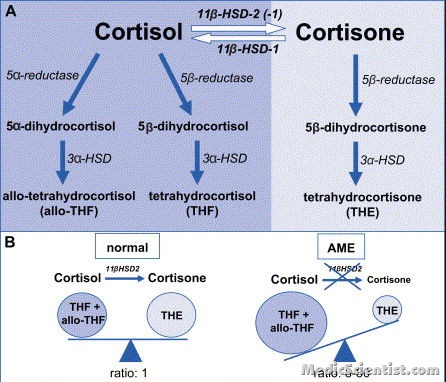Article Contents ::
- 1 Facts about Glucocorticoid & Hypermineralocorticoidism Major side effects
- 2 Definition :
- 3 Hypermineralocorticoidism
- 4 There may be high plasma renin activity called:
- 5 Facts to remember when using glucocorticoids ::
- 6 Glucocorticoid & Hypermineralocorticoidism Table ::
- 7 Glucocorticoid preparations
- 8 Glucocorticoid potency
- 9 Mineralocorticoid potency
- 10 Major side effects associated with corticosteroid therapy
- 11 Dermatologic and soft tissue
- 12 Eye
- 13 Cardiovascular
- 14 Gastrointestinal
- 15 Renal
- 16 Bone
- 17 Neuropsychiatric
- 18 Endocrine
Facts about Glucocorticoid & Hypermineralocorticoidism Major side effects
Definition :
[Gr. gleukos, sweet (new wine), + L. cortex, + Gr. eidos, form, shape] A general classification of adrenal cortical hormones that are primarily active in protecting against stress and in affecting protein and carbohydrate metabolism. The most important glucocorticoid is cortisol (hydrocortisone).
Isolated glucocorticoid deficiency
- It is a rare autosomal recessive disease secondary to a mutation of ACTH receptor.
Adrenoleucodystrophy
- There is severe demyelation and early death in children associated with adrenal insufficiency.
Ad renomyeloneu ropathy
- It is a condition with mixed motor and sensory neuropathy with spastic paraplegia in adults associated with adrenal insufficiency.
Hypermineralocorticoidism
- There may be low plasma renin activity with hypertension and hypokalemia which can be corrected by glucocort;icoids.
There may be high plasma renin activity called:
- 1. Bartter syndrome with severe hyperaldosteronism, with hypokalemic alkalosis and hypercatciuria with normal blood pressure and no edema seen in children. Renal biopsy shows juxta glomerular hyperplasia.
- 2. Gitelman’s syndrome – is an autosomal recessive trait with activation of renin angiotensin aldosterone system with low blood pressure, low serum potassium, low serum magnesium, high serum bicarbonate, low urinary calcium excretion.
- 3. Liddle’s syndrome – There is hyperaldosteronism.
- It is a rare autosomal dominant disease. There is low renin and aldosterone levels.
- 4. Pseudohypoaldosteronism type I is autosomal recessive disorder with salt wasting, hypotension, hyperkalemia, high renin and aldosterone levels seen in neonatal period.
Facts to remember when using glucocorticoids ::
- n tuberculosis or other chronic infections, steroids must be given under antitubercular or antibacterial cover.
- Diabetes mellitus can worsen when steroids are given. Osteoporosis can occur especially in post menopausal patient.
- Peptic ulcer, gastritis, oesophagitis can occur or worsen.
- Hypertension can occur and become refractory. There may be psychological disorders with steroids. Weight gain may occur.
- Sodium intake must be restricted to prevent edema, hypertension and potassium loss.
- Potassium supplements may be given.
- H2 receptor antagonist, antacids should be given.
- Steroid should be gradually tapered or patients put on alternate day regime when requirement is only 20 mg / day.
- It should be stopped when dose of 5 mg/ day is reached.
- For patients on long-term steroids the dose is increased at times of stress.
- Calcium intake should be high 1200 mg/day plus Vitamin D supplements.
- For high-risk patients of osteopenia biphosphonates may be given.
Glucocorticoid & Hypermineralocorticoidism Table ::
Glucocorticoid preparations |
Glucocorticoid potency |
Mineralocorticoid potency |
|
| Short acting | |||
| – | Hydrocortisone | 1 | 1 |
| – | Cortisone | 0.8 | 0.8 |
| Intermediate acting | |||
| – | Prednisone | 4 | 0.25 |
| – | Prednisolone | 4 | 0.25 |
| – | Methyl prednisolone | 5 | 0.01 |
| – | Triamcinolone | 5 | 0.01 |
| Long acting | |||
| – | Beta methasone | 25 | 0.01 |
| – | Dexamethasone | 30 | 0.01 |
Major side effects associated with corticosteroid therapy
|
|
- Thus, when examining studies of glucocorticoid associated AEs, it is necessary to carefully account for the initial indication for steroid use, since such patients are generally “sicker” than those with similar conditions who are not treated with glucocorticoids.


